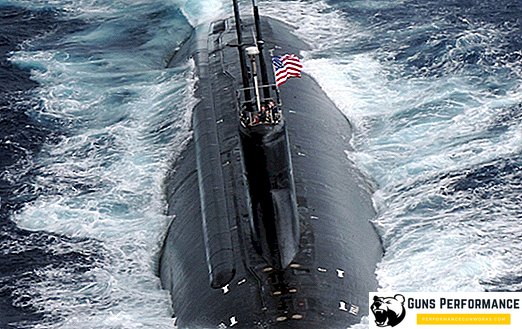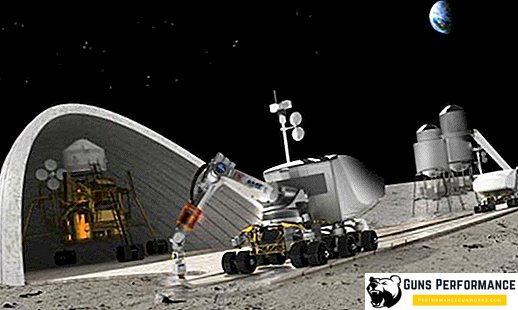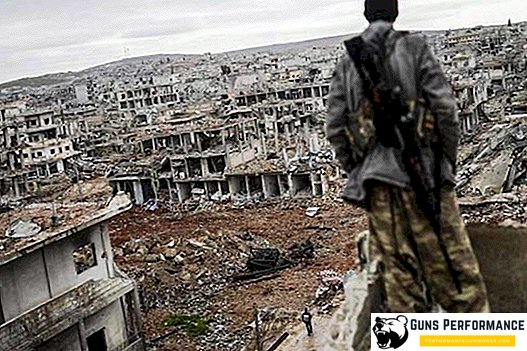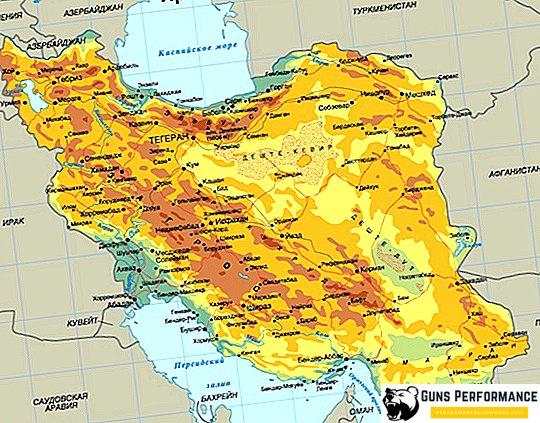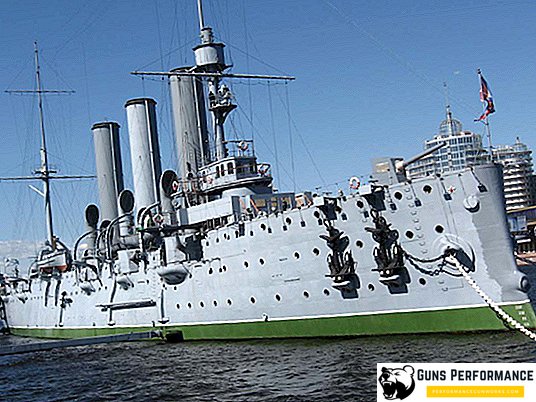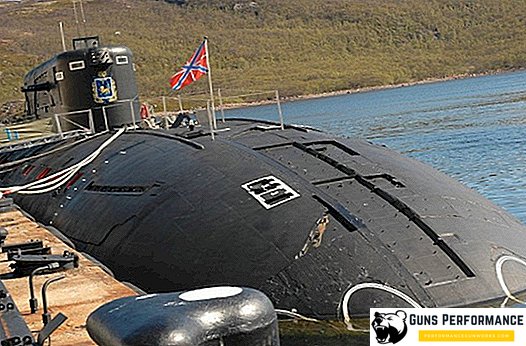... We did for the devil his work.
One of the creators of the American atomic bomb, Robert Oppenheimer
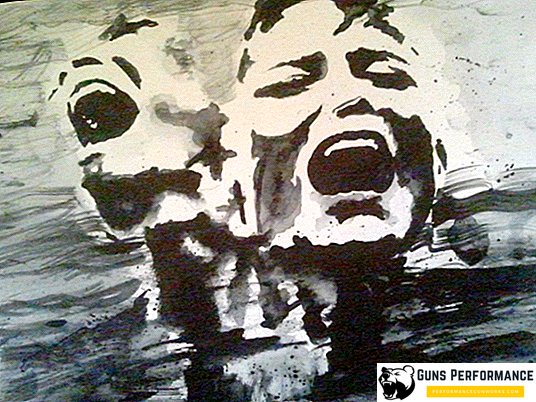
August 9, 1945 in the history of mankind began a new era. It was on that day that the Little Boy nuclear bomb (“Kid”) with a capacity of 13 to 20 kilotons was dropped on the Japanese city of Hiroshima. Three days later, American aircraft struck a second atomic strike on the territory of Japan - the Fat Man bomb was dropped on Nagasaki.
As a result of two nuclear bombings, from 150 to 220 thousand people were killed (and these are only those who died immediately after the explosion), Hiroshima and Nagasaki were completely destroyed. The shock of using new weapons was so strong that on August 15, the Japanese government announced its unconditional surrender, which was signed on August 2, 1945. This day is considered the official date of the end of the Second World War.
After this, a new era began, a period of confrontation between the two superpowers - the United States and the USSR, which historians called the Cold War. For more than fifty years, the world has been balancing on the verge of a large-scale thermonuclear conflict that would very likely put an end to our civilization. The atomic explosion in Hiroshima put humanity in the face of new threats that have not lost their sharpness today.

Was the bombing of Hiroshima and Nagasaki necessary, was this a military necessity? Historians and politicians argue about this to this day.
Of course, a blow to peaceful cities and a huge number of victims among their inhabitants looks like a crime. However, one should not forget that at that time there was the bloodiest war in the history of mankind, one of the initiators of which was Japan.
The scale of the tragedy that occurred in Japanese cities clearly showed the world the danger of a new weapon. However, this did not prevent its further spread: the club of nuclear states is constantly replenished with new members, which increases the likelihood of the repetition of Hiroshima and Nagasaki.

"Project Manhattan": the history of the atomic bomb
The beginning of the twentieth century was a time of rapid development of nuclear physics. Every year, significant discoveries were made in this field of knowledge, people were learning more and more about how matter works. The work of such brilliant scientists as Curie, Rutherford and Fermi made it possible to discover the possibility of a nuclear chain reaction under the influence of a neutron beam.
In 1934, the American physicist Leo Szilard received a patent for the creation of the atomic bomb. It should be understood that all these studies took place in the setting of the approaching world war and against the background of the coming to power of the Nazis in Germany.
In August 1939, a letter signed by a group of renowned physicists was delivered to US President Franklin Roosevelt. Albert Einstein was among the signatories. The letter warned the US leadership about the possibility of creating in Germany a fundamentally new weapon of destructive power - a nuclear bomb.
After that, the Research and Development Bureau was created, which was engaged in atomic weapons, and additional funds were allocated for research in the field of uranium fission.
It must be admitted that American scientists had all the reasons for their fears: in Germany they were really actively engaged in research in the field of atomic physics and had some success. In 1938, German scientists Strassmann and Gan first split the uranium core. And next year, German scientists turned to the country's leadership, pointing to the possibility of creating fundamentally new weapons. In 1939, the first reactor facility was launched in Germany, the export of uranium outside the country was banned. After the start of world war, all German research on the "uranium" theme was strictly classified.
In Germany, more than twenty institutes and other scientific centers were involved in the nuclear weapons project. The giants of German industry were involved in the works, and German Minister of Arms Speer personally supervised them. To obtain a sufficient amount of uranium-235, a reactor was needed, a reaction moderator in which could be either heavy water or graphite. The Germans chose water, which created a serious problem for themselves and practically deprived themselves of the prospects of developing nuclear weapons.
In addition, when it became clear that German nuclear weapons were unlikely to appear before the end of the war, Hitler significantly cut funding for the project. True, the allies had a very vague idea about all this and were seriously afraid of Hitler’s atomic bomb.

American work in the field of atomic weapons have become much more productive. In 1943, the secret Manhattan Project program was launched in the United States, led by physicist Robert Oppenheimer and General Groves. Huge resources were allocated for the creation of new weapons, dozens of world-famous physicists participated in the project. The American scientists were assisted by their colleagues from the UK, Canada and Europe, which ultimately made it possible to solve the problem in a relatively short time.

By mid-1945, the United States already had three nuclear bombs, with a uranium ("Kid") and a plutonium ("Fat Man") filling.
On July 16, the world's first test of nuclear weapons took place: at the Alamogordo test site (New Mexico) the Trinity plutonium bomb was detonated. Tests recognized successful.
Political background of the bombing
On May 8, 1945, Hitler's Germany unconditionally surrendered. In the Potsdam Declaration, the United States, China and the United Kingdom proposed to Japan to do likewise. But the descendants of the samurai refused to capitulate, so the war in the Pacific continued. Earlier, in 1944, the President of the United States met with the British Prime Minister, at which, among other things, they discussed the possibility of using nuclear weapons against the Japanese.
In mid-1945, everyone (including the leadership of Japan) understood that the United States and its allies were winning the war. However, the Japanese were not morally broken, as demonstrated by the battle for Okinawa, which cost the allies enormous (from their point of view) casualties.
The Americans ruthlessly bombed the cities of Japan, but this did not reduce the fury of the resistance of the Japanese army. The United States thought about what losses they will cost a massive landing on the Japanese islands. The use of destructive new weapons should have undermined the morale of the Japanese, breaking their will to resist.

After the issue of the use of nuclear weapons against Japan was resolved positively, the ad hoc committee began to select targets for future bombardment. The list consisted of several cities, and in addition to Hiroshima and Nagasaki, it also included Kyoto, Yokohama, Kokura and Niigata. The Americans did not want to use a nuclear bomb against exclusively military facilities, its use was to have a strong psychological effect on the Japanese and show the world a new tool of US power. Therefore, a number of requirements were put forward for the purpose of the bombardment:
- Cities selected as targets for atomic bombing should be major economic centers, important for the military industry, and also psychologically important for the Japanese population.
- Bombardment should cause considerable resonance in the world
- The military was not satisfied with the city, already affected by air raids. They wanted to more clearly assess the destructive power of the new weapon.
The cities of Hiroshima and Kokura were originally chosen. Kyoto was removed from the list by US Secretary of War Henry Stimson, because in his youth he spent his honeymoon there and was in awe of the history of this city.
For each city, an additional target was chosen, it was planned to strike at it, if the main target for any reason would be unavailable. Nagasaki was selected as insurance for the city of Kokura.
Hiroshima bombardment
July 25, US President Truman gave the order to start the bombing on August 3 and hit one of the selected targets at the earliest opportunity, and the second - as soon as the next bomb is collected and delivered.
At the beginning of summer, the 509th mixed group of the United States Air Force arrived on Tinian Island, the location of which was separate from the rest of the units and was carefully guarded.

On July 26, the cruiser “Indianapolis” delivered the first “Malysh” nuclear bomb to the island, and by August 2 the components of the second nuclear device, the Fat Man, were transported by air to Tinian.
Before the war, Hiroshima had a population of 340 thousand people and was the seventh largest Japanese city. According to other information, before the nuclear bombing, 245 thousand people lived in the city. Hiroshima was located on a plain, just above sea level, on six islands connected by numerous bridges.
The city was an important industrial center and supply base of the Japanese armed forces. Factories and factories were located on its outskirts, the residential sector mainly consisted of low-rise wooden buildings. In Hiroshima was the headquarters of the Fifth Division and the Second Army, which essentially provided protection for the entire southern part of the Japanese islands.

The pilots were only able to start fulfilling the mission on August 6, before this was hampered by heavy clouds. At 1:45 on August 6, an American B-29 bomber from the 509th air regiment as part of a group of escort aircraft took off from the airfield of Tinian Island. The bomber was called Enola Gay in honor of the mother of the aircraft commander, Colonel Paul Tibbetts.

The pilots were confident that dropping an atomic bomb on Hiroshima was a good mission, they wanted the early end of the war and victory over the enemy. Before the departure, they visited the church, the pilots were given ampoules of potassium cyanide in case of danger of being taken prisoner.
The reconnaissance aircraft sent in advance to Kokure and Nagasaki reported that cloudiness over these cities would prevent the bombing. The pilot of the third reconnaissance aircraft reported that the sky above Hiroshima was clear and transmitted a conditional signal.
Japanese radar found a group of aircraft, but since their number was small, the air raid was canceled. The Japanese decided they were dealing with reconnaissance aircraft.
At about eight o'clock in the morning, the B-29 bomber, rising to a height of nine kilometers, dropped an atomic bomb on Hiroshima. The explosion occurred at an altitude of 400-600 meters, a large number of hours in the city, stopped at the time of the explosion, clearly recorded its exact time - 8 hours and 15 minutes.

results
The consequences of an atomic explosion over a densely populated city turned out to be truly horrendous. The exact number of victims of dropping a bomb on Hiroshima was never possible to establish, it ranges from 140 to 200 thousand. Of these, 70-80 thousand people who were near the epicenter, died immediately after the explosion, the rest were much less fortunate. The huge temperature of the explosion (up to 4 thousand degrees) literally evaporated the bodies of people or turned them into coal. The light radiation left imprinted silhouettes of passers-by on the ground and buildings (“the shadows of Hiroshima”) and set fire to all combustible materials several kilometers away.

Following a flash of unbearably bright light, a suffocating blast wave struck, sweeping away everything in its path. The fires in the city merged into one huge fire tornado, which forced a strong wind towards the epicenter of the explosion. Those who did not manage to get out from under the debris, burned in this hellish flame.
After some time, the survivors of the explosion began to suffer from an unknown disease, which was accompanied by vomiting and diarrhea. These were symptoms of radiation sickness, which at that time was unknown to medicine. However, there were also other postponed consequences of the bombing in the form of oncological diseases and the strongest psychological shock; they pursued the survivors decades after the explosion.
It should be understood that in the middle of the last century, people did not understand enough the consequences of the use of atomic weapons. Nuclear medicine was in its infancy, the concept of "radioactive contamination" as such did not exist. Therefore, the people of Hiroshima after the war began to rebuild their city and continued to live in their former places. High cancer mortality and various genetic abnormalities in Hiroshima children were not immediately attributed to nuclear bombardment.
For a long time the Japanese could not understand what had happened to one of their cities. Hiroshima has stopped communicating and broadcasting signals. The plane sent to the city found it completely destroyed. Only after the official announcement from the USA did the Japanese realize what exactly happened in Hiroshima.
Nagasaki Bombardment
The city of Nagasaki is located in two valleys separated by a mountain range. During World War II, it was of significant military importance as a large port and industrial center in which military ships, guns, torpedoes, and military equipment were manufactured. The city has never been subjected to large-scale aerial bombardment. At the time of the nuclear strike in Nagasaki, about 200 thousand people lived.
On August 9, at 2:47 am, the American B-29 bomber commanded by pilot Charles Sweeney with the atomic bomb “Fat Man” on board took off from the airfield on Tinian Island. The primary target of the strike was the Japanese city of Kokura, but heavy clouds prevented the bombing of it. An additional purpose of the crew was the city of Nagasaki.

The bomb was dropped at 11.02 and detonated at an altitude of 500 meters. In contrast to the "Kid", dropped on Hiroshima, "Fat Man" was a plutonium bomb with a capacity of 21 kT. The epicenter of the explosion was located above the industrial zone of the city.
Despite the greater power of the ammunition, the damage and losses in Nagasaki turned out to be less than in Hiroshima. Several factors contributed to this. Firstly, the city was located in the hills, which took over part of the force of a nuclear explosion, and secondly, the bomb worked over the industrial zone of Nagasaki. If the explosion had occurred over residential areas, there would be much more casualties. Part of the area affected by the explosion, generally fell on the water surface.
The victims of the bomb in Nagasaki were from 60 to 80 thousand people (who died immediately or before the end of 1945), the number of deaths later from diseases caused by irradiation is unknown. Different numbers are called, the maximum of them is 140 thousand people.

The city was destroyed 14 thousand buildings (out of 54 thousand), more than 5 thousand buildings were significantly damaged. There was no fire whirlwind observed in Hiroshima in Nagasaki.
Initially, the Americans did not plan to stop at two nuclear strikes. The third bomb was prepared in mid-August, three more were going to drop in September. The US government planned to continue the atomic bombing until the beginning of the ground operation. However, on August 10, the Japanese government handed over proposals of surrender to the Allies. A day earlier, the Soviet Union entered the war against Japan, and the country's position became absolutely hopeless.
Did we need bombing?
The debate over whether it was necessary to drop atomic bombs on Hiroshima and Nagasaki has not subsided for many decades. Naturally, today this action looks like a monstrous and inhuman crime of the United States. Domestic patriots and fighters against American imperialism like to raise this topic. Meanwhile, the question is not unambiguous.
It should be understood that at that time there was a world war, which was distinguished by an unprecedented level of cruelty and inhumanity. Japan was one of the initiators of this massacre and waged a fierce war of conquest since 1937. In Russia, it is often the opinion that nothing serious happened in the Pacific - but this is an erroneous point of view. The fighting in this region led to the death of 31 million people, most of whom - civilians. The cruelty with which the Japanese carried out their policies in China surpasses even the atrocities of the Nazis.
Americans sincerely hated Japan, which they fought since 1941 and really wanted to end the war with the least loss. The atomic bomb was just a new type of weapon, they only had a theoretical idea about its power, and even less knew about the consequences in the form of radiation sickness. I don’t think that if the USSR had an atomic bomb, someone from the Soviet leadership would have doubted whether it should be dropped on Germany. US President Truman until the end of his life believed that he did the right thing by giving the order for the bombing.

In August 2018, it turned 73 after the nuclear bombing of Japanese cities. Nagasaki and Hiroshima today are thriving megacities in which little reminds of the tragedy of 1945. However, if humanity forgets this terrible lesson, then it is likely to happen again. The horrors of Hiroshima showed people what kind of Pandora’s box they had opened by creating nuclear weapons. It was the ashes of Hiroshima that for decades of the Cold War sobered too hot heads, not allowing the unleashing of a new world war.

Благодаря поддержке США и отказу от прежней милитаристской политики Япония стала тем, чем является сегодня - страной с одной из сильнейших экономик в мире, признанным лидером в автомобилестроении и в сфере высоких технологий. После окончания войны японцы выбрали новый путь развития, который оказался куда успешнее предыдущего.


